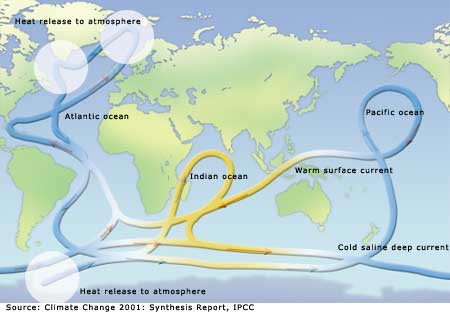The conveyor belt
 The World Ocean Circulation Experiment launched in 1990 has helped researchers better understand what is now called the ocean conveyor belt: the planet's life-sustaining circulatory system. Propelled mainly by prevailing winds and differences in water density, which changes with the temperature and salinity of the sea water, oceans currents are critical in cooling, warming, and watering the planet's terrestrial surfaces and in transferring heat from the Equator to the poles.
The World Ocean Circulation Experiment launched in 1990 has helped researchers better understand what is now called the ocean conveyor belt: the planet's life-sustaining circulatory system. Propelled mainly by prevailing winds and differences in water density, which changes with the temperature and salinity of the sea water, oceans currents are critical in cooling, warming, and watering the planet's terrestrial surfaces and in transferring heat from the Equator to the poles.
The conveyor belt is driven by cold, salty water in the Arctic, which sinks to the bottom and flows south. If the water isn't salty enough to sink, the conveyor belt shuts down. Now, scientists are discovering that Arctic and North Atlantic waters are becoming fresher because of increased precipitation and melting. Without the conveyor belt, Europe and the northeastern US will be far colder. A recent Pentagon report states: "There is a plausible
Related Content
- Joint committee report regarding violations of environmental norms in transportation of coal from Kulda coal mine, 29/11/2022
- Order of the National Green Tribunal regarding air pollution near Shakurbasti Railway Station, Delhi, 28/01/2021
- Order of the National Green Tribunal regarding illegal transportation of coal and its dumping in violation of the pollution norms, Hazaribagh, Jharkhand, 06/01/2021
- Report on air pollution by emission of coal dust and cement dust by operation of JP Cement factory, Churk, Sonbhadra district, Uttar Pradesh, 30/12/2019
- Conveyor belts to be used for eco-friendly Durga idol immersion in Kolkata
- Judgement of the Supreme Court of India regarding mining lessees to to pay 10% of the sale proceeds to the Special Purpose Vehicle, 21/03/2017
